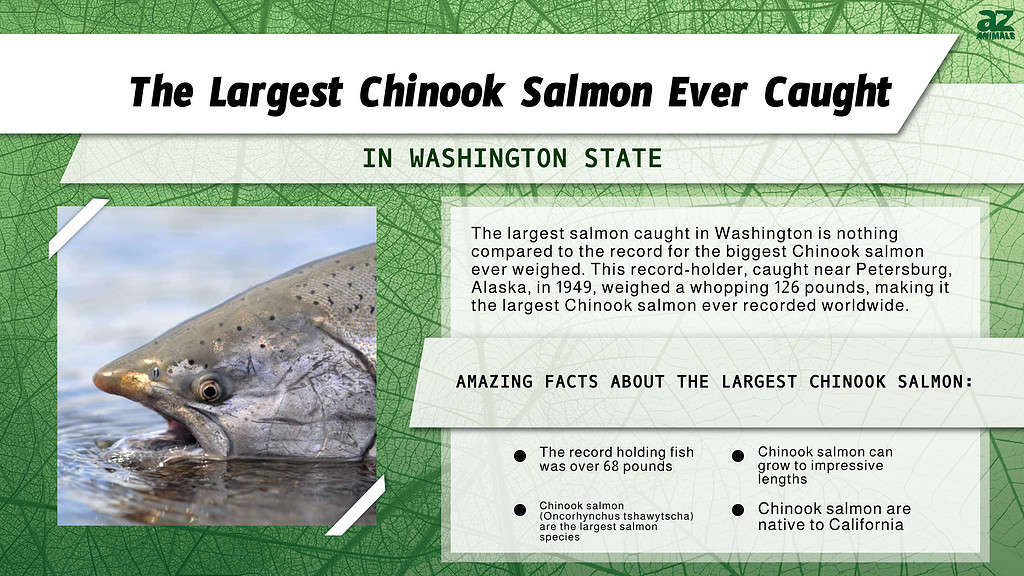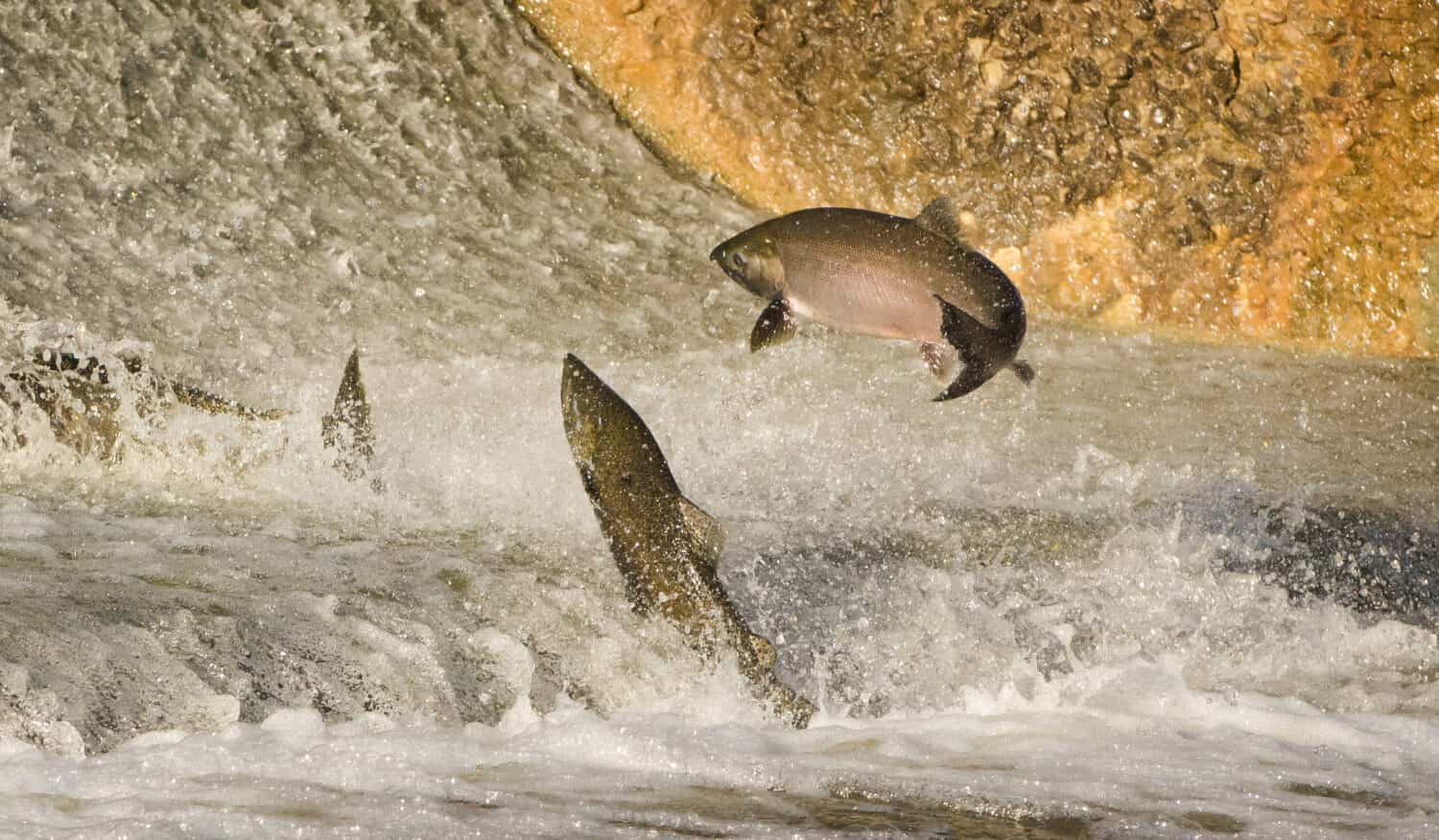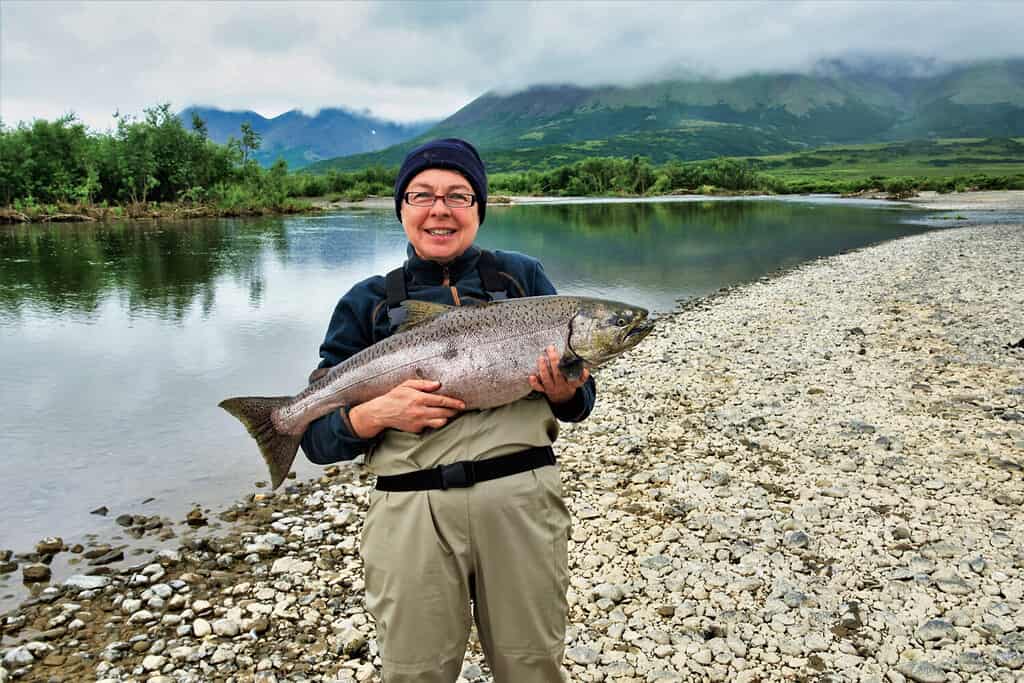
Chinook salmon are the largest of the Pacific salmon, which is why they are also known as “king salmon.” Famous for their robust omega-3 oils and complex taste, Chinook is one of the most sought-after kinds of salmon.
That is why NOAA Fisheries partners with federal, state, tribal, and Canadian officials to protect this species from being overfished. For anglers, the Chinook salmon is a prized catch, not just for its taste but also for its size.
Chinook salmon can grow to impressive lengths, for instance, the largest Chinook salmon ever caught in Washington.
That fish was over 68 pounds!
Description of Chinook Salmon

Native to North America, Chinook salmon may be found in the Monterey Bay area of California all the way up to the Chukchi Sea of Alaska.
©Dec Hogan/Shutterstock.com
Chinook salmon (Oncorhynchus tshawytscha) are the largest salmon in the genus of Oncorhynchus, which incorporates Pacific salmon and Pacific trout.
Blue-green in color on the tops of their bodies, Chinook salmon are silver along the sides. The belly is white, and black spots pattern the upper half of the fish.
When they swim to freshwater to spawn, the Chinook salmon’s coloring changes to olive brown or reddish. The males, in particular, noticeably change to brighter coloring, and their hooked upper jaw is pronounced.
Young Chinook develops parr marks, which is a pattern of vertical bars that helps with camouflaging. As these juveniles mature, they migrate to the ocean, where their coloring changes to a darkened hue on their backs and pale bellies.
Natural Range of Chinook Salmon
Native to North America, Chinook salmon may be found in the Monterey Bay area of California all the way up to the Chukchi Sea of Alaska.
Chinook Salmon Size
Typically, Chinook salmon grow to be three feet long and around 30 pounds. But they have been known to surpass 4.5 feet long and weigh up to 129 pounds.
Diet
When they are young, Chinook salmon prey on insects, amphipods, and other crustaceans. But when they reach maturity, adult Chinook eat fish such as herring, squid, and shrimp.
Habitat

Upon spawning, the Chinook return to the freshwater stream where they hatched.
©Evan Linnell/Shutterstock.com
Young Chinook salmon congregate in freshwater streams, estuaries, or wetlands when they hatch. After they have matured, adult Chinook migrate to the ocean. When it is time to spawn, the Chinook return to the freshwater stream where they originally hatched.
Reproduction
Usually, in the summer or early fall, Chinook salmon return to the same freshwater stream from where they were spawned. Chinook reach sexual maturity somewhere between two and seven years old. But on average, Chinook are three or four years old when they return to freshwater to spawn.
They will burrow into the bottom sediment, forming gravel nests. There, Chinook salmon deposit their eggs. After spawning, the Chinook salmon die.
Traveling from the ocean back to the freshwater streams takes all their energy. And most of the salmon stop eating once they start this journey. After the travel, nest digging, and spawning, there is nothing left, and the fish perish.
It has been shown that the carcasses of these fish add valuable nutrients to the water. This benefits the newly hatched salmon and increases their survival potential.
Best Time to Fish for Chinook Salmon

If fishing in freshwater streams, look for the Chinook salmon in deep pools or runs with moderate water flow.
©Dudarev Mikhail/Shutterstock.com
The peak time to catch Chinook salmon is between the middle of May to the end of July. The fish are most active in the morning or late evening when the water is cooler. And they do most of their hunting in the low light, so sunrise or sunset is a good time to go fishing for Chinook salmon.
If fishing in freshwater streams, Chinook salmon often congregate in deep pools or runs with moderate water flow. This way, they may conceal themselves from predators while waiting for prey to sweep by.
If fishing in the ocean, try to find areas with many baitfish. Where there is concentrated prey, you will also find Chinook salmon. They will also hide near underwater structures like rock piles or drop-offs.
The Largest Chinook Salmon Ever Caught in Washington
Off of the Elochoman River in Wahkiakum County, a record-breaking Chinook salmon was caught on October 5, 1992. It’s fitting that fisherman Mark Salmon would be the one to hook this giant Chinook salmon. His catch was 68.26 pounds, setting a new record for the state of Washington.
The Largest Chinook Salmon Ever Caught

This fisherwoman caught a Chinook salmon from a remote river in the mountains of Alaska. As an example of a typical size for a Chinook salmon, it pales in comparison to the largest ever caught.
©FarFlungFotos/Shutterstock.com
While Mark Salmon may claim the largest salmon ever caught in Washington, it’s nothing compared to the largest Chinook salmon ever weighed on record. Captured in a fish trap near Petersburg, Alaska, this Chinook salmon weighed 126 pounds. Caught in 1949, this is the largest Chinook salmon ever recorded worldwide.
The photo featured at the top of this post is © Evan Linnell/Shutterstock.com
Thank you for reading! Have some feedback for us? Contact the AZ Animals editorial team.







